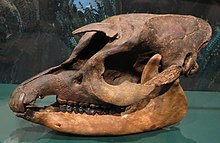Tapirus copei
Tapirus copei, commonly known as Cope's Tapir, is an extinct species of tapir that inhabited North America during the early to middle Pleistocene Epoch (~2.5–1 Ma).[3] The fossil remains of two juvenile Tapirus copei were collected in Hillsborough County, Florida on August 31, 1963.[4] It was the second largest North American tapir; the first being Tapirus merriami.[1]
| Tapirus copei | |
|---|---|
 | |
| A Copes' Tapir skull held at the Natural History Museum in Karlsruhe, Germany | |
| Scientific classification | |
| Kingdom: | |
| Phylum: | |
| Class: | |
| Order: | |
| Superfamily: | |
| Family: | Gray, 1821 |
| Genus: | Brünnich, 1772 |
| Species: | T. copei |
| Binomial name | |
| Tapirus copei Simpson 1945[1] | |
| Synonyms | |
|
Tapirus haysii[2] | |
Taxonomy
There are multiple pieces of evidence which indicate most, if not all, of the 5 accepted Pleistocene tapir species found in North America (T. californicus, T. haysii (T. copei), T. lundeliusi, T. merriami, T. veroensis) may actually belong to the same species. T. californicus was considered to be a subspecies of T. haysii by Merriam,[5] T. californicus and T. veroensis are nearly impossible to distinguish morphologically and occupy the same time frame,[6] being separated only by location, and T. haysii, T. veroensis, and T. lundeliusi are already considered so closely related that they occupy the same subgenus (Helicotapirus).[2] Additionally, few details distinguish T. haysii and T. veroensis except size, date, and wear of teeth;[3] and the intermediate sizes overlap greatly with many specimens originally assigned to one species, then later switched over to another.[3]
References
- Kurtén, Björn. Pleistocene Mammals of North America. p. 293. ISBN 0231516967.
- Hulbert, Richard Jr. (30 September 2010). "A new early Pleistocene tapir (Mammalia: Perissodactyla) from Florida, with a review of Blancan tapirs from the state" (PDF). Bulletin of the Florida Museum of Natural History. 49 (3): 67–126.
- "Tapirus haysii". Florida Museum of Natural History. Retrieved 12 March 2017.
- http://collections.si.edu/search/record/nmnhpaleobiology_3447081
- "Tapirus haysii californicus". Retrieved 12 March 2017.
- Jefferson, George T. (14 August 1989). "Late Cenozoic Tapirs (Mammalia: Perissodactyla) of Western North America" (PDF). Contributions in Science (406).